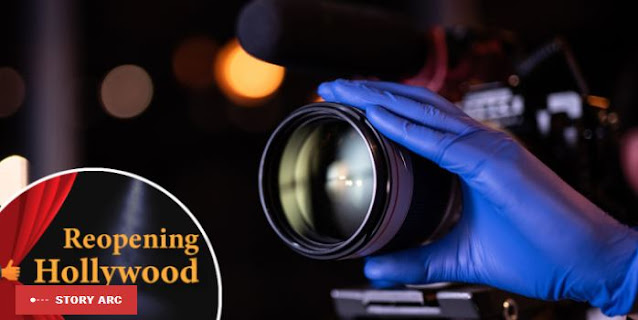After months of brainstorming and negotiations, the Hollywood studios and unions adopted rigorous safety protocols to get TV production going again. And, with fits and starts, it has been going, churning out fresh content with original episodes hitting the air first with the soaps in daytime, followed by unscripted and then scripted series in primetime.
Source:Deadline.com
November 20, 2020
Nellie Andreeva writes:
But it has not been easy. And it has been expensive.
So far, the safety procedures are largely working. There have been many positive COVID tests — both real positives and false positives. There also have been production shutdowns, though no reports of fatalities or seriously ill cast or crew members. (The Good Doctor‘s Richard Schiff is the only known main cast member on a series to be hospitalized with COVID, and he is on the mend.)
At least in part as recognition for the entertainment industry’s efforts, it was given an exemption from California Gov. Gavin Newsom’s new limited stay-at-home order that takes effect Saturday night as the state grapples with a record number of COVID cases. (Film and TV production was not exempt from the sweeping stay-at-home orders in March.) On the list of exemptions for the upcoming restrictions, under “Industrial, Commercial, Residential, and Sheltering Facilities and Services,” there is Essential Worker Designation 15, which reads, “Workers supporting the entertainment industries, studios, and other related establishments, provided they follow COVID-19 public health guidance around physical distancing.”
The return-to-work protocols adopted by the industry do follow public health recommendations and, in some cases, exceed them, stipulating rigorous testing, mandatory mask-wearing and social distancing as well as robust contact tracing.
Crucial to deeming the protocols a success is the fact there have been virtually no cases of on-set transmission, in which a production member is infected by another production member. The COVID infections have originated in staffers’ homes or during their off-work activities and caught by the productions’ extensive and frequent rounds of testing, with mandatory masks and social distancing on set further minimizing spread.
A rising number of Infections among casts and crew amid a third COVID wave across the U.S. is unavoidable unless the entire production team is put in a quarantine bubble, which is difficult to do with dozens of series, each employing hundreds of people. Tyler Perry was able to pull it off at his studio in Atlanta, filming one series at a time over the summer.
Sources attribute the relative success in keeping sets safe to a so-called “Swiss cheese approach” — multiple layers of safeguards, so even if a hole appears in each of them, as a whole, the layers stacked together make for a solid block. With production staff split into zones per industry COVID safety protocols, shows are able to isolate getting more successful in isolating individuals who have tested positive without having to pause production.
ABC’s The Rookie, CBS’ The Young and the Restless and The Bold and the Beautiful, Netflix’s Stranger Things and NBCUniversal’s The Kelly Clarkson Show are among of many series that have continued filming after positive COVID tests. The upcoming American Music Awards also continued rehearsals and pre-production after a handful of crew members tested positive late last week.
Meanwhile, scripted series that have paused production due to positive COVID-19 tests for different periods of time — from one day to two weeks — include CBS All Access’ Why Women Kill, Apple TV+’s Mythic Quest, ABC’s Call Your Mother, Amazon’s Bosch, TNT’s Claws, HBO’s The Gilded Age, Nat Geo’s Genius: Aretha, Netflix’s The Witcher and Vikings: Valhalla, NBC’s Chicago Fire and Chicago Med, Fox’s The Resident, Peacock’s Rutherford Falls, ABC’s For Life, CBS’ Young Sheldon, Disney+’s Big Shot, the CW’s All American and daytime drama Days of Our Lives.
The course of action taken by a production in case of positive COVID tests is informed by science advisors employed by the studios. The decision whether to shut down production also varies based on local regulation: New York, where For Life films, has some of the strictest quarantine guidelines, while Georgia, where Stranger Things is being shot, has less restrictive rules. While it’s made based on the wellbeing of the production team members, that decision has significant financial consequences.
Between the thousands of COVID tests performed each week, adapting the sets to comply with strict safety protocols — including frequent deep cleaning and adjusting all other areas from transportation and location scouting to costume fitting and hair & makeup — reducing work hours and quarantining people, production costs are skyrocketing.
I hear on average, implementing COVID safety protocols adds about $200,000-$300,000 an episode to the budget of a multi-camera comedy series, $300,000-$400,000 an episode for single-camera comedy and $400,000-$500,000 and beyond for a drama. That represents about 10% on top of already hefty production budgets for high-end series, making otherwise profitable shows less profitable and pushing modest performers to break-even or even into the red to turn them into cancellation targets.
Add to that the cost of shutting down production. Each day a production is idle carries a price tag ...

Comments
Post a Comment